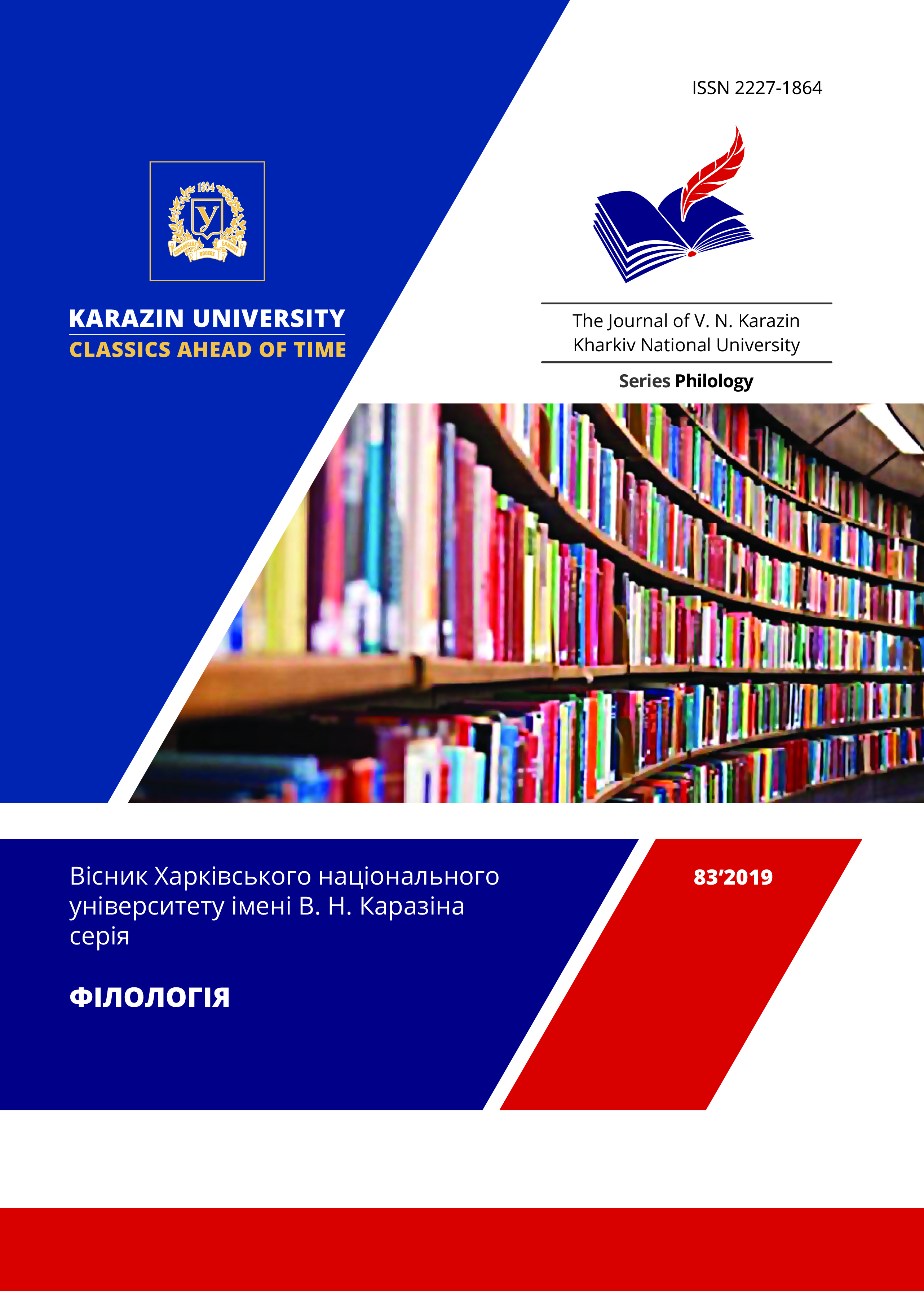Альтернативна історія США в романах Філіпа Діка «Людина у високому замку» (1962) та Філіпа Рота «Змова проти Америки» (2004)
Анотація
У статті пропонується порівняльний аналіз романів Філіпа К. Діка «Людина у високому замку» (1962) та Філіпа Рота «Змова проти Америки» (2004) з точки зору ролі національної культурної міфології США, передусім «американської мрії», у часи випробувань. Обидва твори належать до жанру альтернативної історії з елементами антиутопії та автобіографії. Порівнюються жанрові, сюжетні й наративні особливості цих романів і телесеріалу «Людина у високому замку» (2015–2019): альтернативне історичне тло подій, суб’єктивні та об’єктивні чинники можливості запропонованого авторами ретропрогнозу Другої світової війни, організація сюжету та наративного простору в романах. Альтернативне тло подій (успіх тоталітарного нацистського проекту в США) детально змальовано в обох письменників, проте реальність Діка (окупація США країнами «осі» та втрата національної гідності) більш трагічна, ніж у Рота, який показує тимчасове відхилення від правильного курсу своєю країною, що не призводить до втрати незалежності. Структура творів відрізняється: мультикультурна поліфонія із трьома світами, шістьма сюжетними лініями та сімома фокалізаторами у Діка та лінійність із єдиним фокалізатором і зосередженням на «єврейському питанні» у Рота, – проте обом авторам вдається створити переконливу картину можливого занепаду гуманістичного та демократичного проектів. Розглянуто проблематику романів, зокрема вказано на підводне каміння «американської мрії»: масову свідомість, відсутність критичного мислення, споживацтво, популізм, гонитву за успіхом, антисемітизм, расизм, ксенофобію, надмірне захоплення концепцією «плавильного тигля» тощо. Основний метод порятунку «американської мрії» для авторів – доведення від супротивного: показуючи глобальну історію через локальну, вони поступово розвінчують тоталітарні проекти, які спочатку можуть виглядати вельми привабливо, адже спираються на кращі міфи та очікування масового суспільства.
Завантаження
Посилання
Dik, F. K. (2017). Lyudyna u vysokomu zamku [The Man in the High Castle] / per. z angl. I. Serebryakova. Kyiv : Komubuk. [in Ukrainian].
Krinitskaya, N. I. (2010). Problema realnosti v romane Filipa K. Dika «Chelovek v vysokom zamke» [The Problem of Reality in Philip K. Dick’s The Man in the High Castle]. Materialy XXXIV Mezhdunarodnoy konferentsii OIKS «Otobrazheniye istorii v kulture SSHA» (Moskva, 12–17 dekabrya 2008 g.), M.: MGU, pp. 225–234.
Krynytska, N. I. (2014). Ekranizatsiyi naukovo-fantastychnykh tvoriv Filipa Kindreda Dika v konteksti masovoyi kultury [Screen Adaptations of Philip Kindred Dick’s Sf Works Within the Context of Mass Culture]. Derzhava ta rehiony: naukovo-vyrobnychyy zhurnal. Zaporizhzhya : Klasychnyy pryvatnyy universytet, No 4 (39), pp. 42–47.
Krynytska, N. I. Ontolohichni modeli v romani Filipa K. Dika «Lyudyna u vysokomu zamku» (The Ontological Models in Philip K. Dick’s Novel Man in the High Castle). Aspekty doslidzhennya inozemnykh mov i linhvometodychni osnovy vykladannya: zbirnyk statey. Vyp. 17. Poltava, 2016. S. 28–32.
Latov, Yu. V. (2005). Retroprognozirovanie (kontrfakticheskaya istoriya) kak raznovidnost issledovaniy PATH DEPENDENCE i QWERTY-effektov [Retro-prediction (counterfactual history) as a kind of researching PATH DEPENDENCE and QWERTY effects]. «20 let issledovaniya QWERTY-effektov i zavisimosti ot predshestvuyuschego razvitiya»: internet-konferenciya (15.04.05–5.06.05). Available at: http://ecsocman.hse.ru/text/16213312/.
Brown, W. L. (2006). Alternate Histories: Power, Politics, and Paranoia in Philip Roth’s The Plot Against America and Philip K. Dick’s The Man in the High Castle. The Image of Power in Literature, Media, and Society: Selected Papers, 2006 Conference, Society for the Interdisciplinary Study of Social Imagery. Pueblo, CO, Colorado State University-Pueblo, pp. 107–111.
Carter, C. (1995). The Metacolonization of Dick’s The Man in the High Castle: Mimicry, Parasitism and Americanism in the PSA. Science-Fiction Studies, vol. 67, no. 22, part 3 (November), pp. 333–342.
Chard-Hutchinson, M. (2009). ‘Perpetual Fear’: Repetition and Fantasy in The Plot Against America by Philip Roth. Human Architecture: Journal of the Sociology of Self-Knowledge, vol. 7, issue 2, pp. 145–150.
DePerez, D. (1976). An Interview with Philip K. Dick. Science Fiction Review, No. 19, vol. 5, no. 3. pp. 6–12.
Dick, Ph. K. (1992). The Man in the High Castle. NY: Vintage, 1992.
Geraci, G. (2011). The Sense of an Ending: Alternative History in Philip Roth’s The Plot Against America. Philip Roth Studies, vol. 7, issue 2, pp. 187–204.
Halio, J. L. (2006). The Plot Against America. Shofar, vol. 24, issue 2, pp. 204-206.
Hellekson, K. (2009). Alternate history. The Routledge Companion to Science Fiction / Mark Bould, Andrew M. Butler, Adam Roberts, Sherryl Vint, eds. London : Routledge, pp. 453–457.
Jacobi, M. J. (2006). Rhetoric and Fascism in Jack London’s the Iron Heel, Sinclair Lewis’s It Can’t Happen Here, and Philip Roth’s the Plot Against America. Philip Roth Studies, vol. 6, issue 1, pp. 85–102.
The Man in the High Castle. TV Series (2015– ). Amazon Studios. Produced by Ridley Scott and Frank Spotnitz. Available at: https://www.imdb.com/title/tt1740299/?ref_=nv_sr_1.
Morley, C. (2008). Memories of the Lindbergh Administration: Plotting, Genre, and the Splitting of the Self in The Plot Against America. Philip Roth Studies, vol. 4, issue 2, pp. 137–152.
Palmer, Ch. (2003). Philip K. Dick: Exhilaration and Terror of the Postmodern. Liverpool: Liverpool University Press.
Parrish, T. (2005). The Plot Against America. Philip Roth Studies, vol. 1, issue 1, pp. 93–101.
Roth, Ph. (2004). The Plot Against America. Boston: Houghton.
Shiffman, D. (2009). The Plot Against America and History Post-9/11. Philip Roth Studies, vol. 5, issue 1, pp. 61–73.




